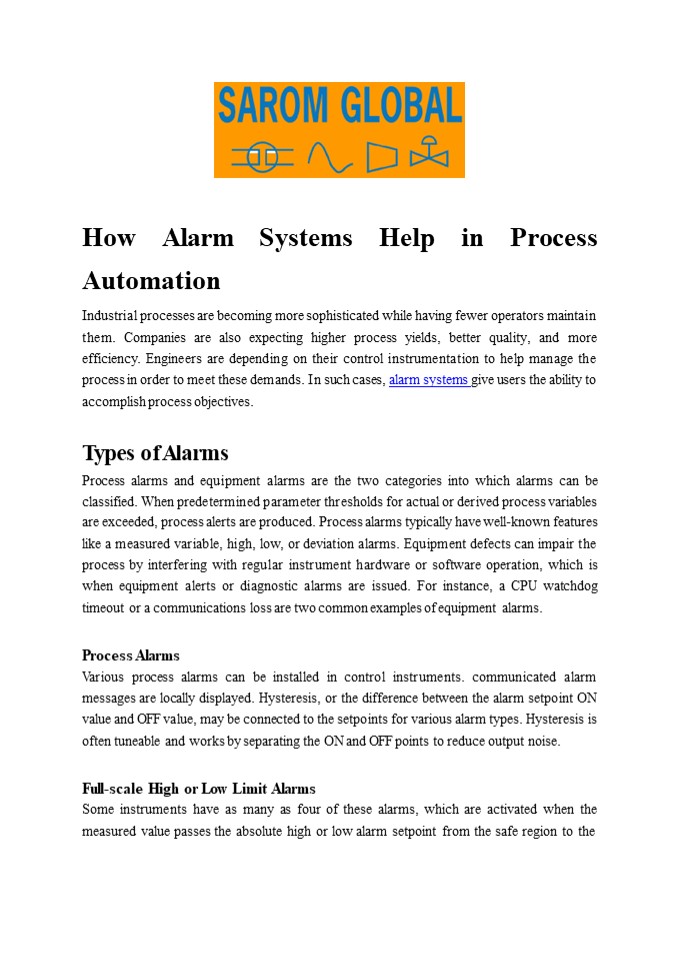How Alarm Systems Help in Process Automation - PowerPoint PPT Presentation
Title:
How Alarm Systems Help in Process Automation
Description:
Industrial processes are becoming more sophisticated while having fewer operators maintain them. Companies are also expecting higher process yields, better quality, and more efficiency. Read more: – PowerPoint PPT presentation
Number of Views:2
Title: How Alarm Systems Help in Process Automation
1
How Alarm Systems Help in Process Automation
Industrial processes are becoming more
sophisticated while having fewer operators
maintain them. Companies are also expecting
higher process yields, better quality, and more
efficiency. Engineers are depending on their
control instrumentation to help manage the
process in order to meet these demands. In such
cases, alarm systems give users the ability to
accomplish process objectives.
Types of Alarms Process alarms and equipment
alarms are the two categories into which alarms
can be classified. When predetermined parameter
thresholds for actual or derived process
variables are exceeded, process alerts are
produced. Process alarms typically have
well-known features like a measured variable,
high, low, or deviation alarms. Equipment defects
can impair the process by interfering with
regular instrument hardware or software
operation, which is when equipment alerts or
diagnostic alarms are issued. For instance, a CPU
watchdog timeout or a communications loss are
two common examples of equipment alarms. Process
Alarms Various process alarms can be installed in
control instruments. communicated alarm messages
are locally displayed. Hysteresis, or the
difference between the alarm setpoint ON value
and OFF value, may be connected to the setpoints
for various alarm types. Hysteresis is often
tuneable and works by separating the ON and OFF
points to reduce output noise. Full-scale High
or Low Limit Alarms Some instruments have as many
as four of these alarms, which are activated when
the measured value passes the absolute high or
low alarm setpoint from the safe region to the
2
alarm region. Generally speaking, HI and LO
alarms just give annunciation, whereas HI-HI and
LO-LO alarms also provide shutdown
interlocks. Deviation Alarms These alarms
contain high, low, and band-type deviations. The
difference between the measured value and the
process setpoint is what triggers a deviation
alarm, and it follows the setpoint if it is
altered. The high and low deviations in the
deviation band alarm can be the same as or
different from the high and low bandwidths. Rate
of Change Alarms This alarm sounds when the rate
of change of the measured value exceeds the value
provided as an alarm setpoint. It is used to
detect changes in the measured value in units per
minute or second. The same alert or two separate
alarms can be set off in response to positive or
negative changes in the measured value. Derived
variables Derived variables can have any of the
aforementioned process alarm types applied in the
same way as real variables. Derived variables
are calculated by programmed algorithms that
mathematically integrate actual variables (such
as averaged thermocouple inputs). Importance of
Alarm Systems In Process Automation The
independent alarms that are integrated into or
programmed into the control instrumentation are
some of the most crucial components that
contribute to process automation and workflow
management. Alarms prevent machine downtime and
preserve good quality. A decent alarm system can
save you a lot of money on labour and supplies.
When the process computer fails, the alarm
operation is maintained by independent monitoring
of alarms from a digital controller or process
alarm unit. Independent alarms are unique from
those produced by a computer supervisory system's
software since they are incorporated into the
instrument's hardware or firmware. In a
continuous control device, such as a discrete
temperature controller, they could perform a
supplementary function. They could also serve as
the main function of a separate process alarm
device that operates as a police officer by
continuously watching one or more process
parameters.
3
An alarm is used to warn a user when a situation
could compromise process quality or protect
people, machinery, or a process from danger. Once
an alarm has been configured, it can be used to
notify a user to begin a human control action,
start an automatic process response in
accordance with predesigned answers, or just
monitor and log the alarm for process
documentation. Digital communications can also be
utilised to send alarms to supervisory
computers, where they can be used to start
control operations and generate logs, reports,
historical files, and more. Integrating an alarm
system changes the whole scenario that helps in
facilitating industrial process automation which
in turn helps in the easy management of the
industrial process. Not only it helps the
process engineers determine the best alarm
response for any particular process condition
but also encourages a safe workplace environment
through predetermining warnings for preventing
accidents and hazards. In addition, today's
process instruments offer enough functionality,
programmability, and alarming options for the
user to design a local alarm strategy that can
best meet the competitive objectives of
operating safely, cutting costs, limiting
downtime, and enhancing quality.
References
https//medium.com/_at_saromglobal/how-alarm-systems-
help-
in-process-automation-7ba7de3e2302
HQ Australia, supporting EMEA (Europe, Middle
East, Africa), Asia Pacific, Americas https//www.
saromglobal.com/ info_at_saromglobal.com 61 2 8317
5089































